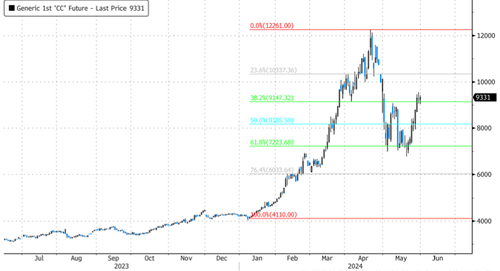
The International Cocoa Organization has admitted that the global cocoa shortage will be significantly larger than previously forecasted. Cocoa prices in New York have rebounded in recent weeks, inching above the $9,330 per ton mark to close the week.
First reported by Bloomberg, ICCO forecasted demand will exceed production by 439,000 tons, driven mainly by higher cocoa grinding in consuming countries. This is the second estimate for the current October-September year and is much larger than the February forecast for a deficit of 374,000 tons.
"Currently available data reveal that cocoa grinding activities have so far been unrelenting in importing countries despite the record cocoa price rallies," the ICCO, adding, "As the 2023-24 season progresses, it is certain the season will end in a higher deficit than previously expected."
After the 'great cocoa' run-up in New York in the first 3.5 months of the year, through the first half of April, from $4,000 a ton to over $12,000 (a record high), prices crashed into May, down 44%. But in the last nine trading sessions, prices have surged to $9,330, or about 39%.
The ICCO has increased its estimate for global cocoa grindings to 4.86 million tons, up from the initial forecast of 4.78 million tons, and increased its production projection by 12,000 tons to 4.46 million tons.
The revised forecast has likely captured the attention of Andurand Capital Management's Pierre Andurand, who has been bullish on cocoa prices this year.
Earlier this month, Andurand joined Bloomberg's Odd Lots hosts Tracy Alloway and Joe Weisenthal to discuss the cocoa trade.
Weisenthal asked the hedge fund manager:
So what did your analyst see? Or how was your analyst able to see something in the supply and demand situation that he felt, and you felt, was not being identified by the analysts who cover this closely?
Andurand responded:
I think it's mainly an understanding of how much prices have to move to balance the market. You know, sometimes people can trade that market for like 20 years. They've been used to a range of prices and they believe, okay, the top of the range is the high price for example.
But they don't really ask themselves what makes that price, right?. And sometimes taking a step back can help. I mean what makes the price is mainly the fact that in the past you would have the supply response if prices were going up. But if now you don't get the supply response, or the supply response takes four or five years, then you need to have a demand response.
And a lot of people look at prices in nominal terms. So you hear people saying 'Oh, we are at all time high prices in cocoa, but that's because they look at prices in nominal terms. [The] previous high in 1977 was $5,500 something dollars a ton of 1977 dollars, which is equivalent to $28,000 a ton of today's dollars.
So we are still very far from previous highs. And so you have to look at a bit more history and understand in the past how prices reacted to a shortage, how long it took to recover the product shortage to actually solve itself. And what's different today.
So there's a ratio that we look at that most people look at, it's actually the inventory to grindings ratio. So it's a measure of inventory to demand, what we call grinding is basically industrial companies that take the cocoa beans and they want to make chocolate with it. So it's a process and some of them make the end product chocolate directly. Some of them sell back the product to other chocolate makers.
And so basically a typical grinder would take cocoa beans and make cocoa butter and powder with it. And the prices of both those elements also went up even more than cocoa beans, which means that actually we probably had some destocking everywhere in the chain.
So it looks like demand, when we look at the chocolate makers, the end demand for chocolate didn't go down at all, it looks to be flat on the year. Grindings look to be down three, three and half percent this year, despite the fact that the end demand is the same in volume, which means that they've been destocking cocoa beans actually.
And so we had destocking everywhere -- at the end chocolate level, at the cocoa beans, at the cocoa butter and cocoa powder level. So we had this destocking everywhere on the chain and now we have the largest deficit ever on top of two previous years of deficit. And it looks like next year we will have a deficit.
So we're in a situation where we might actually run out of inventories completely. I mean this year we think we will end up with an inventory to grinding ratio -- so inventory at the end of the season -- of 21%. For the last 10 years we've been between 35% and 40% roughly. At the previous peak in 1977 we were at 19% and that's what drove us to $28,000 a ton, of todays's dollars.
If we have another deficit next year, then we might go down to 13%. So I don't think it's actually possible. That's when you really have real shortage of cocoa beans, you can't get it and that's when the price can really explode. And so understanding that you have to slow down demand and we know that demand can't really be slowed.
So that's when you can have an explosion [in price]. And remember that these commodity futures, you need to have, they're actually physically settled. So if somebody wants to take delivery, they have to converge with the price of the physical. If you have no physical, somebody wants to take delivery, the price can go anywhere.
So it's a dangerous commodity too short, right? If you have no physical against it. And actually sometimes we read news that the funds have been pushing cocoa prices. It's actually completely untrue because the funds have been selling since February. They actually went from a length of 175,000 lots, so that's 1.75 million tons of cocoa lengths, I think it was around like September last year in average, or a bit earlier, to 28,000 lots to 280,000 tons at the moment.
So they sold more than 80% of their length actually. And the people who've been buying the futures from the funds, it's producers because they're producing a lot less than they expected.
So what has been happening in the cocoa market is that you had a reduction of what we call the open interest, where both the longs would use their length and the shorts would use their shorts. And then we get into a market where you have less liquidity because you have less exposure, you have less longs and less shorts, and then the volatility increases.
So in the past when people were comfortable being, let's say, having a 100 lots position now because it moves more than 10 times more than in the past, we're going to have like a 10 lots position, right? So the market became more -- due to the fact that we had a massive move and we have a massive deficit, so everybody's reducing their positions and because of the increased volatility, we have less activity. And that's what makes the point more volatile as well.
Andurand reaffirmed his $20,000 price target for later this year or next year...
The International Cocoa Organization has admitted that the global cocoa shortage will be significantly larger than previously forecasted. Cocoa prices in New York have rebounded in recent weeks, inching above the $9,330 per ton mark to close the week.
First reported by Bloomberg, ICCO forecasted demand will exceed production by 439,000 tons, driven mainly by higher cocoa grinding in consuming countries. This is the second estimate for the current October-September year and is much larger than the February forecast for a deficit of 374,000 tons.
“Currently available data reveal that cocoa grinding activities have so far been unrelenting in importing countries despite the record cocoa price rallies,” the ICCO, adding, “As the 2023-24 season progresses, it is certain the season will end in a higher deficit than previously expected.”
After the ‘great cocoa’ run-up in New York in the first 3.5 months of the year, through the first half of April, from $4,000 a ton to over $12,000 (a record high), prices crashed into May, down 44%. But in the last nine trading sessions, prices have surged to $9,330, or about 39%.
The ICCO has increased its estimate for global cocoa grindings to 4.86 million tons, up from the initial forecast of 4.78 million tons, and increased its production projection by 12,000 tons to 4.46 million tons.
The revised forecast has likely captured the attention of Andurand Capital Management’s Pierre Andurand, who has been bullish on cocoa prices this year.
Earlier this month, Andurand joined Bloomberg’s Odd Lots hosts Tracy Alloway and Joe Weisenthal to discuss the cocoa trade.
Weisenthal asked the hedge fund manager:
So what did your analyst see? Or how was your analyst able to see something in the supply and demand situation that he felt, and you felt, was not being identified by the analysts who cover this closely?
Andurand responded:
I think it’s mainly an understanding of how much prices have to move to balance the market. You know, sometimes people can trade that market for like 20 years. They’ve been used to a range of prices and they believe, okay, the top of the range is the high price for example.
But they don’t really ask themselves what makes that price, right?. And sometimes taking a step back can help. I mean what makes the price is mainly the fact that in the past you would have the supply response if prices were going up. But if now you don’t get the supply response, or the supply response takes four or five years, then you need to have a demand response.
And a lot of people look at prices in nominal terms. So you hear people saying ‘Oh, we are at all time high prices in cocoa, but that’s because they look at prices in nominal terms. [The] previous high in 1977 was $5,500 something dollars a ton of 1977 dollars, which is equivalent to $28,000 a ton of today’s dollars.
So we are still very far from previous highs. And so you have to look at a bit more history and understand in the past how prices reacted to a shortage, how long it took to recover the product shortage to actually solve itself. And what’s different today.
So there’s a ratio that we look at that most people look at, it’s actually the inventory to grindings ratio. So it’s a measure of inventory to demand, what we call grinding is basically industrial companies that take the cocoa beans and they want to make chocolate with it. So it’s a process and some of them make the end product chocolate directly. Some of them sell back the product to other chocolate makers.
And so basically a typical grinder would take cocoa beans and make cocoa butter and powder with it. And the prices of both those elements also went up even more than cocoa beans, which means that actually we probably had some destocking everywhere in the chain.
So it looks like demand, when we look at the chocolate makers, the end demand for chocolate didn’t go down at all, it looks to be flat on the year. Grindings look to be down three, three and half percent this year, despite the fact that the end demand is the same in volume, which means that they’ve been destocking cocoa beans actually.
And so we had destocking everywhere — at the end chocolate level, at the cocoa beans, at the cocoa butter and cocoa powder level. So we had this destocking everywhere on the chain and now we have the largest deficit ever on top of two previous years of deficit. And it looks like next year we will have a deficit.
So we’re in a situation where we might actually run out of inventories completely. I mean this year we think we will end up with an inventory to grinding ratio — so inventory at the end of the season — of 21%. For the last 10 years we’ve been between 35% and 40% roughly. At the previous peak in 1977 we were at 19% and that’s what drove us to $28,000 a ton, of todays’s dollars.
If we have another deficit next year, then we might go down to 13%. So I don’t think it’s actually possible. That’s when you really have real shortage of cocoa beans, you can’t get it and that’s when the price can really explode. And so understanding that you have to slow down demand and we know that demand can’t really be slowed.
So that’s when you can have an explosion [in price]. And remember that these commodity futures, you need to have, they’re actually physically settled. So if somebody wants to take delivery, they have to converge with the price of the physical. If you have no physical, somebody wants to take delivery, the price can go anywhere.
So it’s a dangerous commodity too short, right? If you have no physical against it. And actually sometimes we read news that the funds have been pushing cocoa prices. It’s actually completely untrue because the funds have been selling since February. They actually went from a length of 175,000 lots, so that’s 1.75 million tons of cocoa lengths, I think it was around like September last year in average, or a bit earlier, to 28,000 lots to 280,000 tons at the moment.
So they sold more than 80% of their length actually. And the people who’ve been buying the futures from the funds, it’s producers because they’re producing a lot less than they expected.
So what has been happening in the cocoa market is that you had a reduction of what we call the open interest, where both the longs would use their length and the shorts would use their shorts. And then we get into a market where you have less liquidity because you have less exposure, you have less longs and less shorts, and then the volatility increases.
So in the past when people were comfortable being, let’s say, having a 100 lots position now because it moves more than 10 times more than in the past, we’re going to have like a 10 lots position, right? So the market became more — due to the fact that we had a massive move and we have a massive deficit, so everybody’s reducing their positions and because of the increased volatility, we have less activity. And that’s what makes the point more volatile as well.
Andurand reaffirmed his $20,000 price target for later this year or next year…
Loading…





